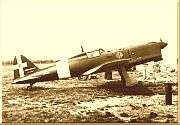Ambrosini SAI.207
| SAI.207 | |
|---|---|
 | |
| Role | Light fighter |
| Manufacturer | Società Aeronautica Italiana / Ambrosini |
| Designer | Sergio Steffanuti |
| First flight | Spring 1941 |
| Primary user | Regia Aeronautica |
| Number built | 14 |
| Variants | Ambrosini SAI.403 |
The Ambrosini SAI.207 was a light fighter interceptor built entirely from wood and developed in Italy during World War II. Powered by a single 750 hp Isotta-Fraschini Delta, the SAI.207 enjoyed limited success during evaluation of the 12 pre-production aircraft.[1]
Development
The SAI.207 was developed from the Ambrosini SAI.7 racing and sporting monoplane after the light fighter concept had been proven with the Ambrosini SAI.107 prototype. Steffanuti designed the aircraft to have a lightweight structure and light armament to allow lower-powered engines to be used, without unduly reducing performance.
The first of three prototypes was completed and flown in the Autumn of 1940 as the sole SAI.107, which was a minimum change fighter development of the SAI.7, with identical dimensions, apart from length, at 8.02 m (26.31 ft) and the 402.7 kW (540 hp) Isotta-Fraschini Gamma engine. Weighing only 1,000 kg (2,205 lb) the Sai.107 reached a speed of 563 km/h (350 mph) in trials held at the Guidonia research establishment and manoeuvrability proved to be excellent. The SAI.107 was lost, along with pilot Arturo Ferrarin, in a crash on 18 July 1941.
Two more fighter prototypes were built as SAI.207s, flying for the first time in the spring of 1941 and 1942.
Design

The SAI.207 was a single-seat, low-wing monoplane with a conventional tail-wheel undercarriage, developed from the Ambrosini SAI.7. Of wooden construction, giving a light structure, power was supplied by 559.3 kW (750 hp) Isotta-Fraschini Delta R.C.40 engine, cooling air entering the engine through a central intake. Armament consisted of two 12.7 mm (0.500 in) Breda-SAFAT machine guns.
In level flight the performance of this aircraft was impressive, achieving a speed of 580 km/h (360 mph)[2] and over 800 km/h (497 mph) in a dive. The Ministero dell' Aeronautica soon placed a production order for 2,000 machines, plus a pre-production batch of 12 aircraft for operational testing. After the mixed results of operational evaluation and the signing of the Armistice, no production aircraft were built.
Operational history
Flight testing revealed some major shortcomings, most of which were not rectified before the Armistice in 1943; the low power and high wing loading resulted in poor climb performance; the light structure prevented more powerful cannon from being used as the recoil forces overstressed the mounting structure; the rear cylinders of the engine overheated during recovery from a dive; the light structure also led to problems, with the second prototype wing exploding during a dive recovery due to internal pressure built up, caused by the lack of internal fairings in the undercarriage bays. The wooden structure was also badly affected by rain or humidity.
The pre-production batch of 12 aircraft served briefly with three squadrons. The first was 83rd Squadriglia, 18 Gruppo, 3 Stormo, led by Guglielmo Specker, one of the Regia Aeronauticas best known "aces", at Cerveteri airfield, near Rome. The aircraft entered service in July 1943, flying a number of combat missions against heavy Allied raids over the Italian capital, but without success. After one month, they were sent to Castiglione del Lago G.Eleuteri airfield (at that time one of the main RA training airbases), where it was planned that 161 and 162nd Squadriglia would take the aircraft into service.
Despite its speed, Italian pilots were not impressed by the type and its service in the summer of 1943 quickly ended. The aircraft of 83rd Squadriglia were returned to SAI-Ambrosini to be refurbished, but the Armistice made it impossible for them to return to their squadron.
Operators
Specifications (SAI.207)
Data from Italian Civil and Military aircraft 1930–1945[3]
General characteristics
- Crew: 1
- Length: 8.0201 m (26 ft 3.75 in)
- Wingspan: 9.004 m (29 ft 6.5 in)
- Height: 2.87 m (9 ft 5 in)
- Wing area: 13.90 m2 (149.6 sq ft)
- Empty weight: 1,750 kg (3,858 lb)
- Gross weight: 2,415 kg (5,324 lb)
- Powerplant: 1 × Isotta-Fraschini Delta inverted V-12 air-cooled piston engine
Performance
- Maximum speed: 641 km/h; 346 kn (398 mph)
- Cruise speed: 489 km/h; 264 kn (304 mph)
- Range: 850 km; 459 nmi (528 mi)
- Service ceiling: 12,000 m (39,370 ft)
- Rate of climb: 13.25 m/s (2,608 ft/min)
- Time to altitude: 6,000 m (19,685 ft) in 7 minutes 33 seconds
Armament
- Guns: 2 × 12.7 mm (0.500 in) Breda-SAFAT machine guns
plus (MM8433 only) 2 × 20 mm (0.787 in) cannon
See also
- Aircraft of comparable role, configuration and era
- Related lists
References
- Notes
- Bibliography
- Angelucci, Enzo and Paolo Matricardi. World Aircraft: World War II, Volume II (Sampson Low Guides). Maidenhead, UK: Sampson Low, 1978. ISBN 0-562-00096-8.
- Cattaneo, Gianni. SAI-Ambrosini 207 e derivati (in Italian & English). Roma, Italy: La Bancarella Aeronautica, 2005.
- Emiliani, Angelo. "Il Volo e la Scaramanzia" (in Italian). Storia Militare magazine No.77, February 2000.
- Green, William. Warplanes of the Second World War, Volume Two: Fighters. London: Macdonald & Co. (Publishers) Ltd., 1961.
- Lembo, Daniele I caccia SAI-Ambrosini (in Italian). Aerei nella Storia magazine No.39, December 2003.
- Taylor, Michael J. H. Jane's Encyclopedia of Aviation. London: Studio Editions, 1989.
External links
| Wikimedia Commons has media related to Ambrosini SAI.207. |